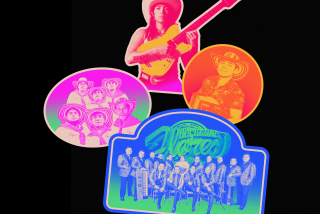ARTISANS: Spotlighting Makers of Handcrafted Good : Music Store Offers Art for Those Marching to a Different Beat
- Share via
Gino Zenobia is busy drumming up business.
As the owner of Zenobia Music in Laguna Beach, Zenobia has been creating and selling with his wife, Jackie, handmade, historically accurate drums and percussion instruments for more than 12 years. Most of his customers are not particularly interested in drumming, but are intrigued by the design and history of the pieces.
“People like to decorate their homes using more ethnic looks,” he says. “These kinds of instruments fit in well if the decor is African, Indian or South American. People will often group several different types of drums or shakers together as a collection. And they’re quite a conversation piece. If folks see one, they just have to try it out to see what it sounds like.
“Some of my best customers are men in their 50s and 60s who are developing an appreciation for drums not only as instruments but as art forms in their own right.”
Zenobia’s collection consists of about 40 varieties of instruments, and prices for the pieces can range from about $4 for a simple shaker up to $3,000 for a custom-crafted piece.
Among the instruments Zenobia sells from his home or at one of several art fairs he attends throughout the year (he is a regular exhibitor at the Sawdust Festival in Laguna Beach), are many African and South American-influenced styles.
The African Kuda drums, for example, are two wooden hoops of different sizes that have goatskin stretched and attached to one side. They are played with sticks and are usually accompanied with agogo bells or cowbells. They are reminiscent of today’s tambourines.
A more unusual instrument is an African musical bow, which has a thin wire--instead of twine or string--strung from end to end. It also has a gourd that is hollowed out and shaped like a bowl. When attached to the bow, the gourd acts as a resonator or amplifier. The sound is made by the player striking the wire with a thin stick, causing a high vibrating sound.
The vibrating pitch is changed by allowing the gourd bowl to touch the player’s body or by extending it from the body. The instrument, known as the berimbau in Brazil, creates its sound when the player uses a flat stone or washer that is pressed into the string, adding to the exotic buzzing or humming sounds.
Zenobia also makes instruments such as a gonza, which is a tube shaker played much like a maraca, agogo bells which are funnel-shaped, flat bells of different sizes and a shakeree, which is a gourd covered with netting and beads that can either be shaken or turned to create a rattling sound. Another rattle, the caxixi, consists of a small basket or basket-shaped form filled with seeds, beads, shells or anything that will click together when shaken.
A cricket makes a sound much like the insect from which it gets its name. The chirping sound is produced by three small metal balls clanging against a metal bar.
“Shakers of all types are always of interest to people,” said Zenobia. “We have all kinds, usually made out of gourds and decorated with painting, beads or feathers depending on what region it is from. Shakers and drums are really what I call ‘world instruments,’ meaning that you’ll find them almost everywhere.”
The African xylodrum is one of the most popular drums that Zenobia makes. He has merged African tones and Western scales to create an exotic drum with eight to 10 notes and is tuned in either pentatonic or diatonic scales. This makes the drum easy to play and very melodious. Its ancestor is generically known as a log or slit drum and was traditionally used to communicate from village to village. Some log drums have been known to be eight to nine feet long, creating a sound that could be heard about to a quarter of a mile away.
African thumb pianos (also called sanza or mberia) are created by attaching small tines to a gourd or box. Two sound holds drilled in the gourd allow the instrument to vibrate creating a distinctive vibrato hum.
Think back to nursery school days and you may remember an instrument based on the reco reco, a scraper that originated in Mexico and South America, and known there as a guiro. Notches were carved along the side of a length of bamboo or gourd and a stick was used to scrape against it. By covering or uncovering the hole in the bottom of the instrument, the player makes a different sound.
Some instruments come fully prepared, courtesy of Mother Nature.
“I also collect tree pods that come directly from the trees,” Zenobia said. “They dry out and make instant rattles.”
A current favorite are the rain sticks, which can even be found in large stores and catalogues. These hollowed-out pieces of bamboo are filled with seashells, seeds or rocks. The ends of the stick are sealed tightly. When tipped, the sound is surprisingly like that of a rainfall. The longer the stick, the more realistic the sound. By twisting and tilting the rain stick gently, the sound can range from a soft rainfall to a downpour.
Zenobia also fashions a variety of chimes designed to be played rather than stirred by the wind.
Why the growing interest in ethnic instruments?
“There’s more interest in ethnic music for starters,” Zenobia said, adding, “I think there’s a better appreciation for handcrafted items. Each piece is a little bit different depending on the bend of the wood or the size of the gourd or the color of the paint. You could probably buy something similar elsewhere, but most of my customers like the fact that these instruments are made out of the same materials as their original counterparts.
“I think the drums and chimes have a spiritual feeling,” he said. “They’re relaxing to listen to, and when you’re driving along the freeway every day, it’s nice to have something peaceful to come home to.”
More to Read
The biggest entertainment stories
Get our big stories about Hollywood, film, television, music, arts, culture and more right in your inbox as soon as they publish.
You may occasionally receive promotional content from the Los Angeles Times.










